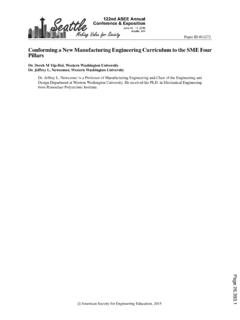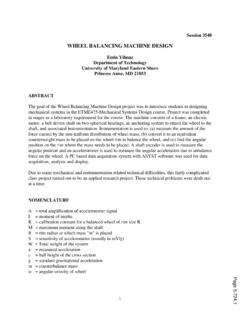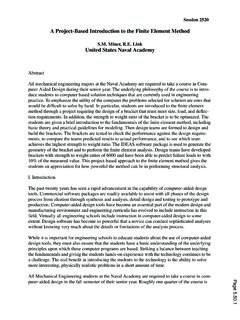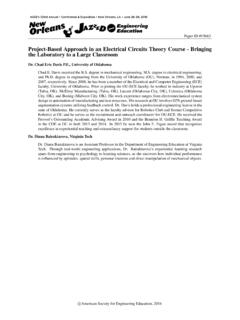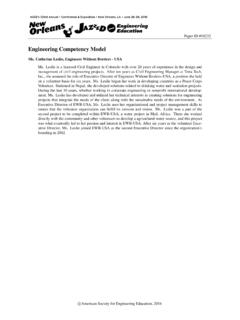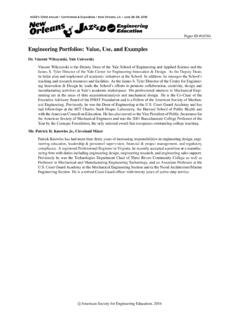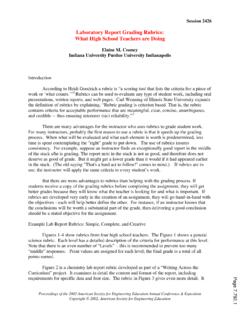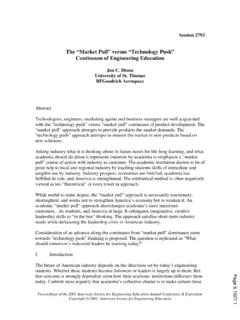Transcription of Aerodynamic Performance of the NACA 2412 Airfoil at Low ...
1 Paper ID #15014 Aerodynamic Performance of the naca 2412 Airfoil at Low Reynolds Num-berDr. John E Matsson, Oral Roberts UniversityJohn Matsson is a Professor of Mechanical Engineering at Oral Roberts University in Tulsa, OK. Heearned and degrees from the Royal Institute of Technology in Stockholm, Sweden in 1988and 1994 A. Voth, Oral Roberts UniversityJohn Voth is a current Sophomore Undergraduate student at Oral Roberts University studying mechanicalengineering. He is also a member of he American Society of Mechanical Engineers and a Fellow inORU s Honors Connor A. McCain, Oral Roberts UniversityConnor McCain is an undergraduate engineering student at Oral Roberts UniversityMr.
2 Connor McGraw, Oral Roberts UniversityConnor McGraw is currently a sophomore at Oral Roberts University studying Mechanical American Society for Engineering Education, 2016 Aerodynamic Performance of the naca 2412 Airfoil at Low Reynolds Number Abstract This paper shows a project by three honors students in an undergraduate engineering program. Students used a 3D printer to fabricate a wing section of the naca 2412 Airfoil . The section has a chord length of 230 mm and a total assembled width of 305 mm. The wing was printed in three separate, hollow sections including a 25mm wide inner section and two 140mm wide outer sections assembled on each side of the inner section. The inner section contained 36 surface holes that were attached by copper tubes and Tygon tubing connected to a multi-manometer.
3 The experiments were compared with CFD simulations using ANSYS Fluent software. Detailed descriptions of the experimental design, fabrication, set-up, learning process and cost are included in the paper together with links to tutorials to repeat the experimental setup as well as a tutorial of the mesh generation and settings for the CFD simulations. Finally, the paper will provide a description of the outcomes for the project, student involvement and response, and an assessment of the student learning procedure. Introduction The experimental setup described in this paper is used for hands-on learning experience in labs for the introduction to engineering, fluid mechanics, and experimental methods courses at the university.
4 Students who complete these labs apply conceptual knowledge that they have gained from multiple undergraduate courses. The point of this experiment is to familiarize students with a few basic aerospace concepts and terms such as Reynold s number, coefficient of lift, and coefficient of pressure1-4. Furthermore, it teaches students how to read a multi-manometer5 and perform and compare calculations obtained from experimental data and theoretical/virtual simulations. This experimental setup was inspired by a published paper by Dr. John Matsson titled, A Student Project on Airfoil Performance 6. In his experiment, data gathered from LabVIEW software is compared to data obtained from CosmosFloWorks.
5 The experiment detailed in this paper, however, contributes the use of the powerful simulation software ANSYS, as well as data obtained from a student designed multi-manometer, which allows students to observe the real-time effects of the experiment. In addition, the Airfoil in this experiment was 3D printed in order to provide more precise results and allow for additional measurement points. The wing used in this experiment is an extrusion of the naca 2412 Airfoil . The wing was 3D printed in three hollow sections and joined together by two aluminum spars that spanned the width of the three sections. The locations for the surface holes were precisely placed in the SOLIDWORKS model and were created during the printing process using an Objet24 printer.
6 The multi-manometer was designed and constructed by the honors students. The model was conceived in SOLIDWORKS before being fabricated in the university machine shop. It contains thirty-six separate tubes joined together on a board. The board is hinged to a base and is capable of resting at 30, 35, 40, 45, and 50 degrees above the horizontal base. Polycarbonate tubing is used for the straight section of each of the individual manometers. Tygon tubing connects the top ends of the polycarbonate tubing to the surface holes along the wing. Tygon tubing is also used to connect the bottom ends of the polycarbonate tubes to a colored-water filled container. (A detailed explanation of the design and fabrication of the multi-manometer can be found in the appendix.)
7 ANSYS software was used for virtual testing of the aerodynamics of the naca 2412 Airfoil . Using the Fluid Flow (Fluent) solver7, the coordinates of the naca 2412 Airfoil were rotated against the wind velocity vector to simulate varying angles of attack. Then, the theoretical coefficients of drag and lift were calculated at varying levels of mesh quality to compare with the experimental results. The naca 2412 Airfoil is part of the NACA 4 digit series of Airfoil classification8. The four digits are determined by the characteristics of the Airfoil in the following way: 1. The first digit describes the maximum camber as a percent of the chord. 2. The second digit describes the location of that maximum camber measured from the leading edge in percent of the chord.
8 3. The final two digits describe the maximum thickness of the Airfoil in percent of the chord. With all percentages given in respect to the length of the chord, the classification of the naca 2412 determines that the Airfoil has a maximum camber of 2% located at 40% from the leading edge, with a maximum thickness of 12%. The professor desired to experiment with the learning process of the honors students. He provided them with a project and allowed them to learn about the different subjects involved while they worked to complete this project rather than teaching all of the information to them before they attempted the project. He offered instruction throughout the process, but also allowed some learning through failure.
9 The students learned new aspects of SOLIDWORKS, ANSYS, and manufacturing by practical experience during this project. Theory The pressure distribution over the surface of the Airfoil is described by the dimensionless parameter known as the coefficient of pressure = 12 2= 0 =1 ( )2 (1) where the velocity ratio is defined by, = 0 0 (2) where is the freestream fluid velocity, 0 is the stagnation pressure9 that is assumed to be constant through the whole flow-field, is the freestream static pressure, is the density of air, is the pressure at a specific point along the surface of the Airfoil , and is the fluid velocity at the same point.
10 The freestream fluid velocity is determined from Bernoulli s equation, 0= +12 2 (3) = 2( 0 ) (4) The pressure difference 0 is determined by, 0 = (5) = ( ) (6) where is the density of water, is the gravitational acceleration constant, is the vertical height difference, is the measured change in height of the water in the multi-manometer, and is the angle the multi-manometer makes with the horizontal base. The density of air is found using the ideal gas law, = (7) where is the atmospheric pressure measured in Pascals, is the temperature measured in Kelvin, and is the universal gas constant, measured in J/kg*K.


